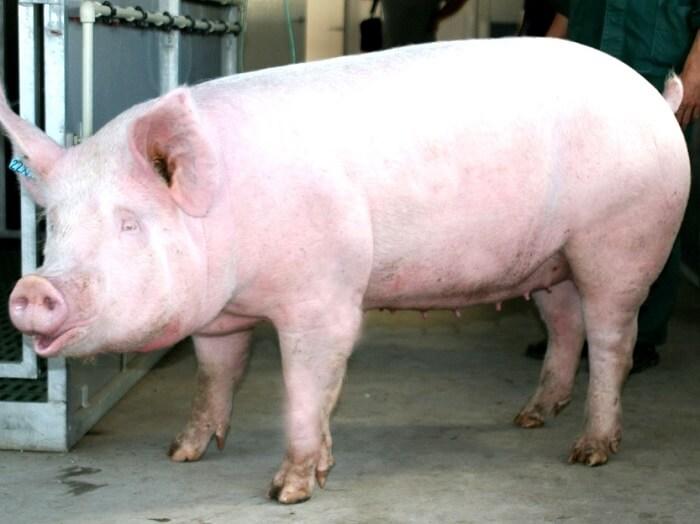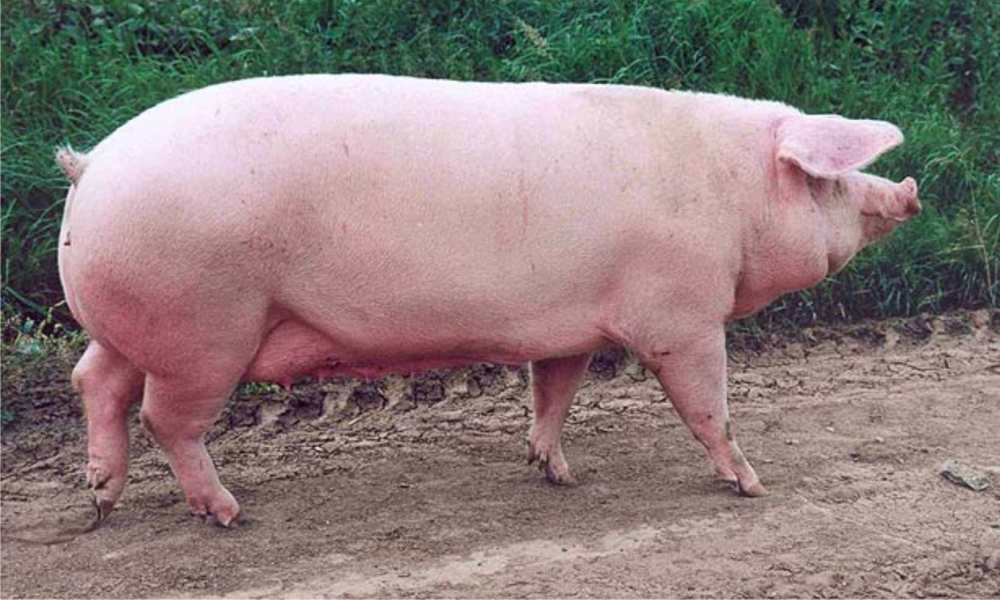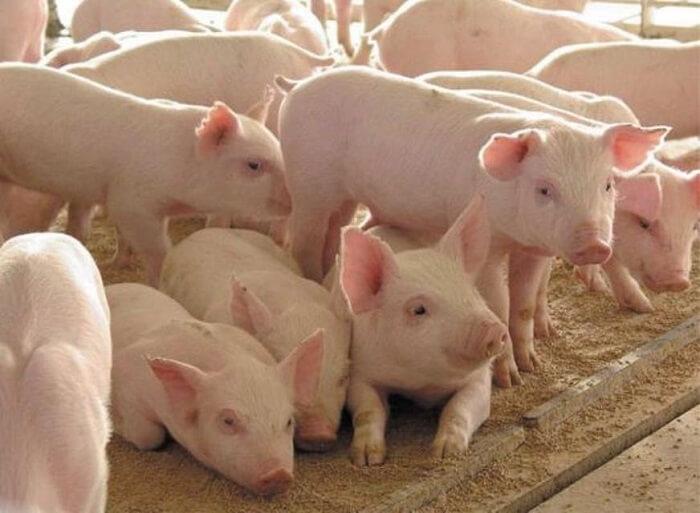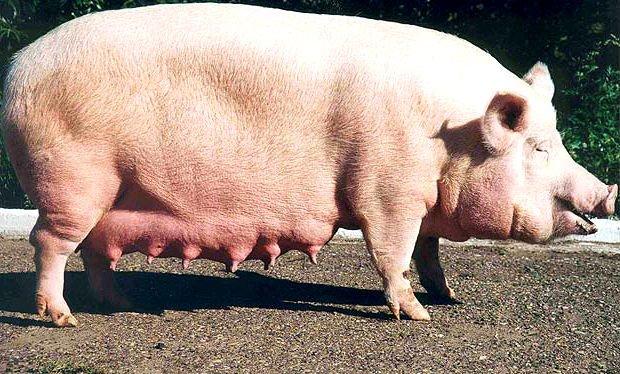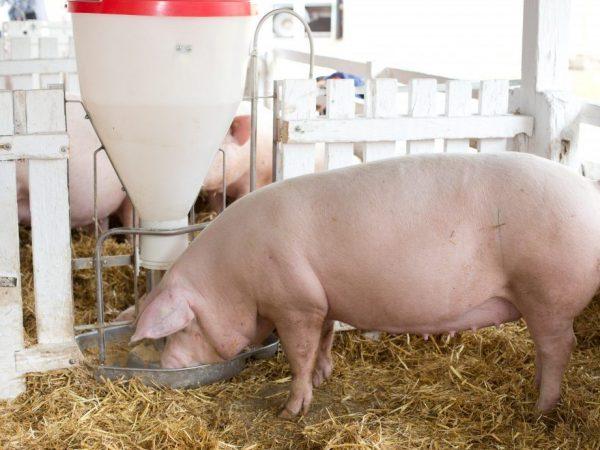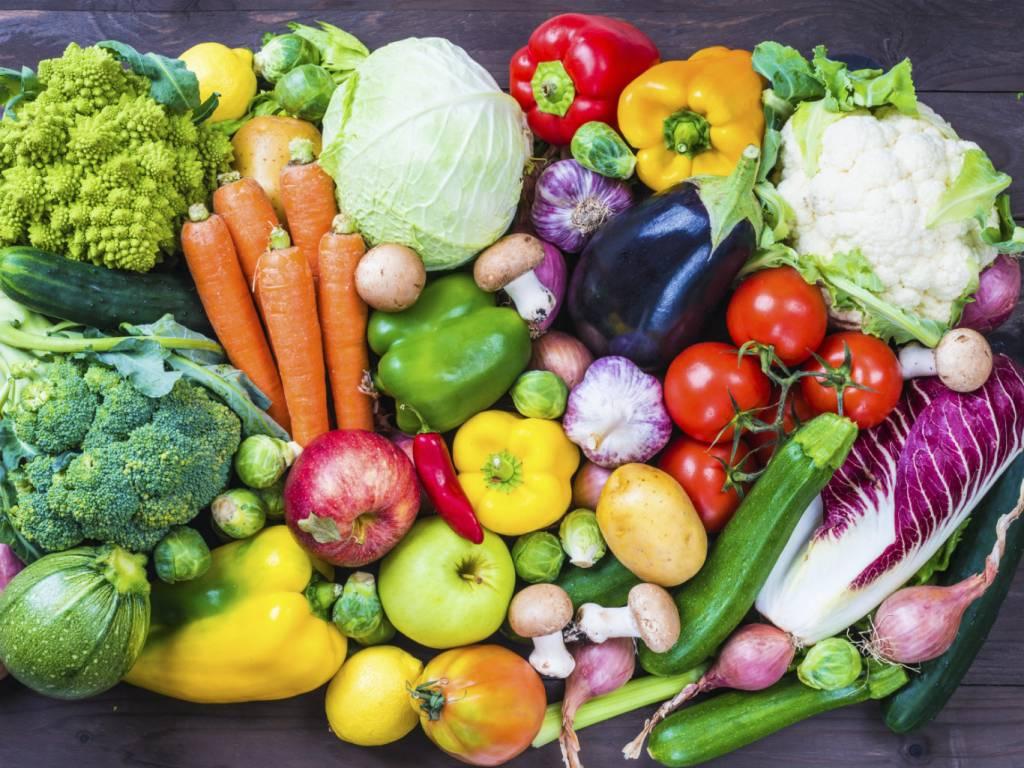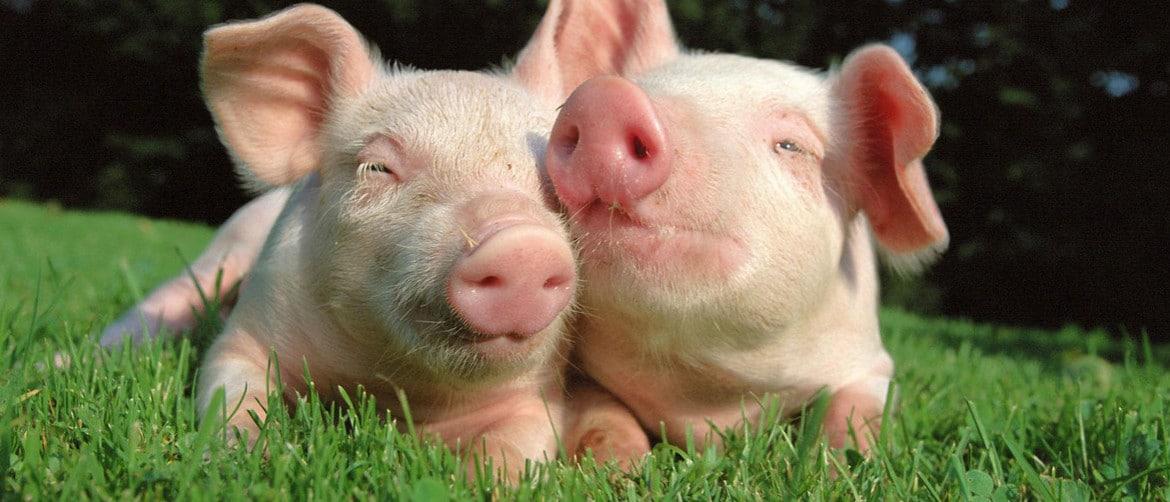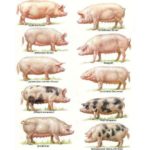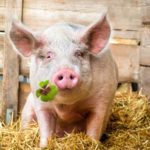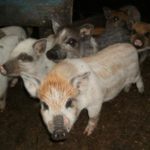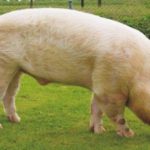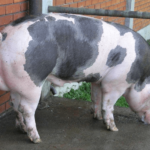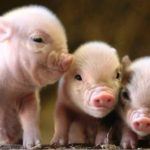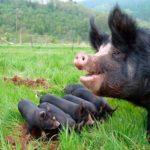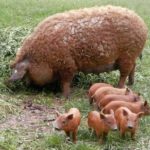When talking about pigs, people imagine a typical domestic pig with a plump, barrel-shaped body and a pink snout. A similar characteristic can be given to several breeds, but the white large breed of pigs is considered classic. Such pigs are found in every livestock complex, farm and household. They adapt to all living conditions and are characterized by high productivity, which has earned them worldwide popularity.
History of appearance
England is considered the birthplace of large white pigs. Initially, long-eared pigs were bred there, but over time they began to improve them through more careful selection and created better living conditions for them. As a result, breeders developed the Leicester pig.
Next, the breeding of the large white pig occurred in stages:
- In the 19th century, accelerated modernization of breeds began to occur. The local March and Leicester breeds of pigs began to be crossed with Romanesque (Neapolitan, Portuguese) and Asian (Siamese) varieties. Selection work was carried out in almost every livestock farm.
- In the 1830s, a British cattle breeder developed a stable breed of pigs with high productivity, but small dimensions. The breed was called "small white". The animals were not popular because they were demanding of their living conditions.
- In 1851, the offspring of the long-eared Leicester pig and the small white pig were exhibited at an agricultural exhibition. The piglets had high productivity and fertility, and good meat characteristics. The breed was called the Yorkshire pig, and it was immediately appreciated by English breeders.
- To prevent the breed from degenerating, in 1885 breeders began to develop a unified standard and establish a stud book. Since then, the official name of the breed has been large white pig.
The export of large white pigs to the Russian Federation and European countries occurred in the 1890s. War and economic devastation negatively affected the breeding of the breed in Russia; English breeding pigs degenerated by 80%. When the political situation stabilized, the country decided to create a state pig-breeding industry.For this reason, in the 1920s, Great Britain imported ~700 animals to Russia, which were used to breed Soviet pigs.
Russian and English pigs had differences: the former had a massive constitution, high fertility, and were more easily adapted to the harsh Russian frosts. Previously, when breeding pigs, attention was focused on the quality of lard, which led to a decrease in the specific gravity of meat breeds. In the 1990s, consumer demand changed, with greater emphasis placed on the meat quality of animals.
Description, characteristics and productivity of the large white breed
Large white pigs have a strong constitution and heavy weight. A boar weighs 330-355 kg, and a pig weighs 225-255 kg. Animals have strong bones, harmonious, regular physique. The body is massive, long - 192 cm in males, 169 cm in females. The head is of medium size, the forehead is wide, the snout is of medium length. Representatives of the breed are distinguished by a deep chest, wide back, and massive loin.
The neck is wide and long, the legs are of medium definition. The shape of the ribs is rounded, the paws are strong, with powerful hooves. The eyes are small, dark in color. Pigs have a light pink skin tone, its structure is dense and elastic. The pig's body is covered with thin, dense bristles. There are no spots or marks on the body. Individuals of the large white breed are characterized by a calm, phlegmatic character. The white large breed of pigs has the following productivity characteristics:
- Animals are early maturing - they gain 750 g of weight in 24 hours. Individuals weighing 100 kg are taken for slaughter; piglets gain this weight within six months after birth. In order for a pig to gain 1 kg of weight, 4 kg of feed must be spent on it.
- By the 1st year the animal gains about ~200 kg.An adult sow weighs 240-255 kg, a boar gains up to 355 kg.
- The slaughter weight of the carcass to the pre-slaughter weight of the pig is 81%. The meat is penetrated with thin layers of fat, which gives it juiciness and softness.
- High level of fertility - an adult sow gives birth to 10 to 14 piglets.
Among the modern livestock of large white pigs, the following productive varieties are distinguished:
- meat;
- meat-greasy;
- greasy.
Preference is given to animals of the meat-fat (universal) variety.
Main pros and cons
Large white pigs have earned enormous popularity due to:
- Adaptation to the harsh conditions of the Russian climate.
- Unpretentiousness to food. Animals respond well to replacing feed with quality products. But if the farmer cannot feed them with quality feed, they have no problem consuming what they are given.
- Flexible genetic structure and excellent meat quality. Large white pigs are famous for their “marbled” meat.
- High fertility. A large number of offspring leads to a rapid increase in the population with a small number of broodstock. This helps reduce the cost of meat products.
- Excellent precocity. Within six months, the piglets gain the required weight and are ready for slaughter. This helps to reduce the cost of the product, in contrast to late-ripening pigs, which require more feed units.
Farmers are often afraid to breed large white pigs because of:
- Tendency to obesity.
- Soft cheeks.
- Drooping sacrum.
- White color, which appears when walking animals in places unprotected from the sun.
- Sensitivity to frost, sun. Pigs are not driven to pastures in areas with a southern climate, where in summer the air temperature exceeds +30 °C.With the onset of winter in the northern regions, animals are not taken out of the stall.
- High fat content. For many years, Russian breeders have paid special attention to breeding the greasy type of animals. In the modern world, people have switched to meat, due to which the demand for breeding individuals of the meat and meat-fat type has increased.
Large white pigs are popular among Russian breeders due to the balance of positive and negative aspects of their breeding. The breed has many advantages compared to other breeding pigs.
How to keep the breed
To keep a large white breed, it is necessary to equip a warm pigsty, think through a ventilation system, and install a lot of lighting fixtures. The pigsty must be divided into zones where pigs can sleep, walk, swim, and eat.
The place where the piglets will be is equipped with a pen of 3 m2; for the sow, the area is expanded by 1-1.5 m2 more. The suckling queen is allocated 6.5 m2; the area must be comfortably arranged and cleaned regularly. Particular attention is paid to the strength of the structure and fence, since animals can easily destroy a flimsy partition or dig under it.
Piglets need five meals a day and a comfortable stall. The water in containers should be cool - this will prevent intestinal infections and disorders in animals.
Nutritional Features
Large white pigs are recommended to consume food rich in vitamins and minerals - they facilitate the animals’ adaptation to temperature changes. Pigs need spacious pastures, protected from the scorching sun, and long walks. The best diet for animals would be foods like:
- potatoes;
- carrots;
- beets;
- radishes;
- pears;
- apples;
- dairy products;
- peas;
- alfalfa;
- feed;
- barley;
- oats;
- wheat;
- rye;
- cabbage leaves;
- legumes;
- zucchini;
- corn;
- pumpkins.
The young are fed boiled root vegetables, plant foods, wheat and whey. One piglet consumes 2.5-3 kg of feed in 24 hours. It is recommended to add salt to the food.
Breeding rules
The large white breed of pigs is distinguished by early sexual maturity - they become adults as early as six months. It is recommended to carry out the first mating in the 8th month - this way the female will be able to bear the cubs normally and fully. The healthiest offspring are considered to be piglets that the sow gave birth to in the 10th month.
Mating should be prepared in advance, choosing the right time. The female's arousal can be determined by the redness and swelling of the genitals, from which discharge oozes. The piggy restlessly rushes around the stall, grunts, squeals and refuses to eat.
At the peak of sexual activity, the female becomes motionless, inviting the male to copulate. Pregnancy in large white pigs lasts up to 4 months. Before giving birth, the sow's genitals swell, the mammary glands become greatly enlarged, and the belly drops. The expectant mother moves restlessly around the stall, making herself a bed out of straw.
Every breeder should know how to make labor easier for a pig. After birth, the piglets' snouts, ears, and mouth are cleaned, removing excess mucus. After this, they proceed to wiping the torsos with a soft towel and cutting the umbilical cords. Iodine is used to cauterize the navel. Next, the piglets are brought to their mother to suck on colostrum.
It is recommended to bring the pigs to the mother, even if she is giving birth to an afterbirth at that moment. This is necessary to increase the vitality of the babies, relieve the pain of the sow and speed up the completion of labor.
Prevention and treatment of diseases
Large white pigs are susceptible to pneumonia, scabies, and helminths. It is important to carry out treatment in a timely manner, regularly clean the pigsty and bathe the pigs 4 times a year. At the first signs of pneumonia, you need to call a veterinarian and give the animal 1 tablet of paracetamol - it will relieve the fever.
Pigs may become depressed or apathetic - this indicates they are overheating. A sick pig's gait changes, its heart rate becomes irregular, and its pulse quickens. The extreme degree of the disease is characterized by convulsions, vomiting, and foam from the sinuses. Before the doctor arrives, the pig is wiped with a wet rag, taken outside, and given water. If the condition worsens, the animal is given intravenous glucose and caffeine.
Is it profitable to start
Large farms need a large white pig breed for good profitability. A high level of fertility contributes to the rapid increase in livestock. Animals consume food in moderation, compensating for it with the excellent quality of meat. Small farmers and private households benefit from the breed due to its ease of maintenance.

